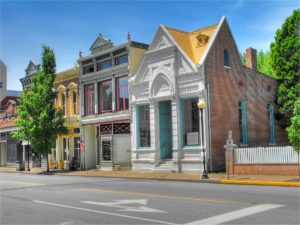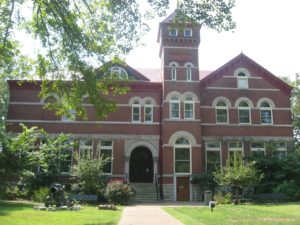Scarlett
New Harmony, Indiana: A Site of Failed Utopia, yet Model of Peaceful Existence
“Exchange their poverty for wealth, their ignorance for knowledge, their anger for kindness, their division for union.” – Robert Owen
Scrolling through images of New Harmony, a town situated over only 0.65 square miles of western Indiana, emulates traveling back in time 100 years. At first glance,

it resembles a rather simple, quaint existence, emblematic of a typical American small town. However, upon more thorough investigation, its history is far more nuanced and complex a narrative.
Founded as “Harmony” in 1814, the town was first home to a religious group, commonly referred to as the “Harmonists,” or the “Harmony Society.” Led by German leader George Rapp, this sect believed in the Second Coming, and lived purely and honorably to prove their worthiness of Jesus’ return. In addition to practicing celibacy, they were abolitionists and promoted communal living and equality. Yet despite the Harmonists’ success, the location of their settlement was not ideal for trading practices. This geographical inconvenience, in tandem with the opposition they faced from slave-owning neighbors, prompted their decision to settle elsewhere.
In 1824, they sold this land, along with its 180 buildings to Robert Owen, who changed the name of the community to “New Harmony,” as it remains to this day. Disillusioned with religion, Owen conceived his own doctrine, grounded in the notion that an individual’s environment is paramount in shaping their character and identity.

To that end, central to this ideology was the quest to achieve a utopia, a perfect society unencumbered by social classes and segregation. Like the Harmonists, this philosophy promoted equality for all, condemning slavery and supporting women’s rights, as well as endorsing free education and communal living.
Despite having a constitution designed to govern life and foster happiness, accord and unity within the society, Owen’s community lacked organization in terms of a structured government and formal leadership. Additionally, conflicting philosophies regarding the role of religion further exacerbated the growing disorder and disillusionment within the community. Amidst this dissent, Owen extricated himself from New Harmony, and departed for England, where he continued disseminating his utopian mission. Around the same time, followers who had been drawn to the promise of a collaborative, harmonious, orderly existence in a crime, disease and poverty-free “utopia” began to move away, abandoning the communal lifestyle.
By 1829, after failed efforts to implement structure and reconcile disorganization within the town, New Harmony officially dissolved, dispersing into smaller neighboring communities.
On paper, this attempt at a utopia in New Harmony appears to embody many characteristics of other communities we have studied, from its promise of a perfect, untroubled experience to its emphasis on equality. However, Owen’s focus on and commitment to free education as a core pillar of society stands out from other attempted utopias. With no religious slant, he believed in education as a vehicle to achieve enlightenment and a truly moral existence, and according to Owen, “man is a creature of his circumstances.” Based on this conviction, he believed that children should be immersed in education from a young age, distinguishing this environment as the best to ensure their proper growth and development in terms of both intellect and character. Indeed, he envisioned “a system of national education” that would prevent idleness, poverty, and crime among the ‘lower orders,'” and believed that “[training] children from their earliest infancy in good habits” through education would “impress them with an active and ardent desire to promote the happiness of every individual” (A New View of Society and Other Writings, Robert Owen). He also emphasized the importance of experiential learning, promoting the value in children both genuinely enjoying their schooling and having the freedom to engage in discussion, exploration and think deeply beyond a traditional classroom setting.
In some respects, today’s inhabitants of New Harmony continue to model the simplistic ways of life of the Harmonists and the Owenites. And a host of historic

buildings remain intact to this day, from a library to a museum to an opera house, all contributing to its enduring charm and quaint appeal. The town also continues to bear the name of “New Harmony,” and in a sense, its residents still live up to this name, signifying the commune’s success in leaving a legacy of lasting harmonious life. However, I believe it is important to distinguish harmony from utopia. After all, one of the downfalls of this commune was that its members were not unified by a particular code or set of religious beliefs. Rather, they came together over the shared desire for harmony. But with only a reliance on this commonality as a means of unification and no structured system of leadership in place, their conflicting visions for how to achieve a utopia remained just that: mere unrealized figments.
Sources:
https://www.atlasobscura.com/places/the-roofless-church-new-harmony-indiana
https://newharmony-in.gov/about-new-harmony.php
https://www.biographyonline.net/business/robert-owen.html